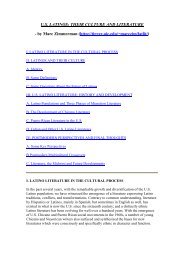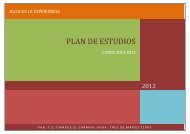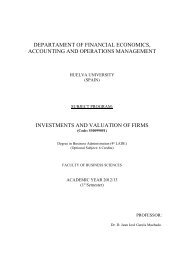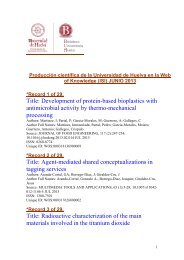1º Derivación Parcial y Diferencial
1º Derivación Parcial y Diferencial
1º Derivación Parcial y Diferencial
You also want an ePaper? Increase the reach of your titles
YUMPU automatically turns print PDFs into web optimized ePapers that Google loves.
Derivando respecto de x, considerando y constante, obtenemos<br />
para (x, y) = (0, 0).<br />
f ′ x(x, y) = (3x2 y − y 3 )(x 2 + y 2 ) − (x 3 y − xy 3 )2x<br />
(x 2 + y 2 ) 2<br />
= y(x4 + 4x2y2 − y4 )<br />
(x2 + y2 ) 2 ,<br />
Derivando ahora respecto de y, considerando x constante, resulta<br />
para (x, y) = (0, 0).<br />
f ′ y(x, y) = (x3 − 3xy 2 )(x 2 + y 2 ) − (x 3 y − xy 3 )2y<br />
(x 2 + y 2 ) 2<br />
= x(x4 − 4x2y2 − y4 )<br />
(x2 + y2 ) 2 ,<br />
Para calcular las derivadas parciales en el origen debemos acudir a la<br />
definición:<br />
f ′ f(x, 0) − f(0, 0)<br />
x(0, 0) = lím<br />
x→0 x − 0<br />
0<br />
= lím<br />
x→0 x<br />
= lím 0 = 0<br />
x→0<br />
f ′ f(0, y) − f(0, 0)<br />
y(0, 0) = lím<br />
x→0 y − 0<br />
0<br />
= lím<br />
y→0 y<br />
= lím 0 = 0.<br />
y→0<br />
= lím<br />
x→0<br />
= lím<br />
y→0<br />
0<br />
x2 − 0<br />
x − 0 =<br />
0<br />
y2 − 0<br />
y − 0 =<br />
Ahora estamos en condiciones de proceder a calcular las derivadas par-<br />
ciales de segundo orden en el origen:<br />
f ′′<br />
f<br />
yx(0, 0) = lím<br />
x→0<br />
′ y(x, 0) − f ′ y(0, 0)<br />
x − 0<br />
x − 0<br />
= lím<br />
x→0 x − 0<br />
15<br />
= 1<br />
=<br />
=<br />
=

















